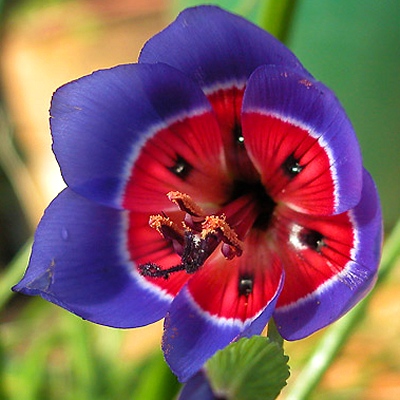"Wine Cup"
Planting the bulbs
The bulbs come out of dormancy in early autumn - around October in the northern hemisphere. Before then, keep the bulbs in a cool spot. (In the southern hemisphere, i recommend storing your bulbs in the refrigerator until March/April). Pot size -- They tend to look best in a single pot, but you may plant them in individual pots. Pots should be 3-4 inches tall (7-10 cm), and wide enough so there is 1 inch (2.5 cm) between each other and the sides of the pot. In warmer climates, it's best to use slightly larger pots made of clay, to keep the soil cooler. Either way, use pots with drainage holes. Soil -- Geissorhiza does best in a sandy soil mix. A typical mix is 1 part potting soil to 2 parts coarse horticultural sand or perlite (fine- or medium-sized perlite, not large chunks). Cover the bulbs with about 1 inch (2.5 cm) of soil. Water the soil lightly - only enough to make the soil slightly moist throughout. Keep it this moist until they sprout. Do not fully saturate the soil. Keep the pot in a spot that will be about 60-77° F (16-25°C) during the day. A little cooler at night is ok, but keep them from freezing. When you see the grass-like leaves emerge, increase the watering. Until they go dormant, keep the soil evenly moist (avoid keeping it constantly saturated). Light -- Full sun (or the equivalent artificial light) is preferred throughout winter, but in warmer climates, they might need some protection from strong midday sun. Fertilizer -- A week after they sprout, give them a liquid fertilizer. Hydroponic fertilizer is ideal for this, since it is easily absorbed and complete. Repeat 2 more times at 1 month intervals. Avoid feeding in the spring. Climate -- It comes from a climate that has mild temperatures during the winter growing season. From late autumn through mid-spring, it prefers temperatures between 40° and 80°F (4-27° C), with cool nights. I don't know if it will thrive outside that temperature range, especially if nights are warm (above 65°F / 18°C). In warmer conditions, shade the pot, perhaps by placing it inside a larger clay pot. Protection from frost is essential. Dormancy care -- When the leaves start to die back in the spring, stop the watering. During the summer dormancy, keep the soil relatively dry (but avoid letting it get bone-dry). It's not necessary to dig up the bulbs. Simply move the pots to a cool, dry spot until autumn. In autumn, water lightly, then wait for leaves to appear. Have fun growing them! - Jeff Strange Wonderful Things
|
|||||||||


